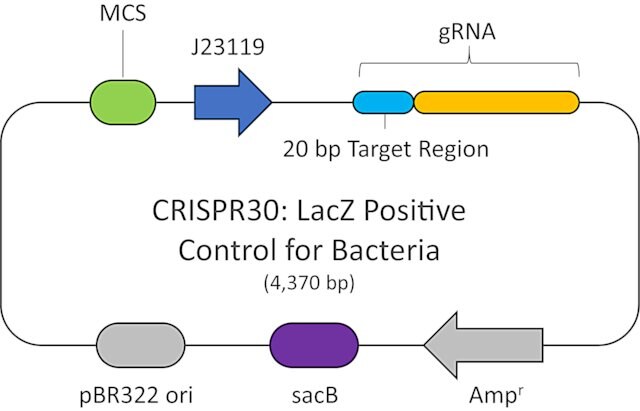您的位置:首页 > 产品中心 > CRISPR LacZ Positive Control plasmid for Bacteria
CRISPR LacZ Positive Control plasmid for Bacteria

产品性质
| packaging【包装】 | vial of 50 μL |
| concentration【浓度】 | 20 ng/μL in TE buffer; DNA (1μg of purified plasmid DNA) |
| technique(s) | microbiological culture: suitable |
| Promoter【启动子】 | Promoter activity: constitutive |
| application(s) | CRISPR genome editing |
| shipped in【运输】 | dry ice |
| storage temp.【储存温度】 | −20℃ |
基本信息
| General description【一般描述】 | Recent publications using CRISPR/Cas9-mediated recombineering in E. coli tout editing efficiencies near 100%, making CRISPR/Cas9-mediated recombineering the most powerful bacterial genome engineering method to date. In addition, Cas9-mediated recombineering overcomes the dependence on a second recombination step, avoids the creation of destabilizing scar sites, can be used in multiplexing, and is less time-consuming than previous protocols. Here we present a novel dual-vector CRISPR/Cas-mediated λ-Red system for improved recombineering in E. coli. Our system is shown to facilitate homology-directed repair of DSBs created by Cas9 endonuclease, enabling genetic alterations through chromosomal integration of a donor DNA. This plasmid is to be used in combination with the Cas9 Lambda Red homologous recombination plasmid for E. coli (CAS9BAC1P) as the positive control for your custom gene editing experiment. The custom gRNA (CRISPRBACD) can be designed and ordered through https://www.sigmaaldrich.com/pc/ui/genomics-home/customcrispr The CRISPR LacZ Positive Control Plasmid for Bacteria (CRISPR30) contains a gRNA spacer targeting the lacZ gene in wild-type E. coli expressed constitutively from a J23119 promoter, a ampicillin resistance marker, a pBR322 origin of replication, and a sacB gene from Bacillus subtilis for counter-selection-based curing. |
| Application【应用】 | Bacterial Genome Editing
Strain Optimization |
| Features and Benefits【特点和优势】 | Efficient: increased efficiency of HR-mediated integration Markerless: does not require antibiotic resistance marker insertion Scarless: no scar sequences from marker excision which often cause off-target recombination Multiplexing: multiple custom gRNA sequences can be used at a time |
| Principle【原理】 | CRISPR/Cas systems are employed by bacteria and archaea as a defense against invading viruses and plasmids. Recently, the type II CRISPR/Cas system from the bacterium Streptococcus pyogenes has been engineered to function using two molecular components: a single Cas9 protein and a non-coding guide RNA (gRNA). The Cas9 endonuclease can be programmed with a single or dual gRNA, directing a DNA double-strand break (DSB) at a desired genomic location. Nuclease-based methods are largely toxic when employed as microbial gene editing tools because many bacteria lack the necessary DNA repair mechanisms found in eukaryotic systems. However, when CRISPR/Cas9 is used to mediate recombineering, this cytotoxic quality offers an advantage in that Cas9-induced double stranded breaks kill cells that do not recombine with the donor DNA. This provides an inherent method of selection for markerless, scarless gene editing that is dramatically more efficient and more amenable to multiplexing than traditional methods. The E. coli HR Positive Control Plasmid (Catalog Number CRISPR30) contains a gRNA sequence targeting the lacZ gene in wild-type E. coli. and is designed to be used in conjunction with the E. coli HR Cas9 Plasmid (Catalog Number CAS9BAC1P) and a ssDNA donor template. |
| Legal Information【法律信息】 | CRISPR Use License Agreement |
安全信息
| Storage Class Code【储存分类代码】 | 12 - Non Combustible Liquids |
| WGK | WGK 2 |




